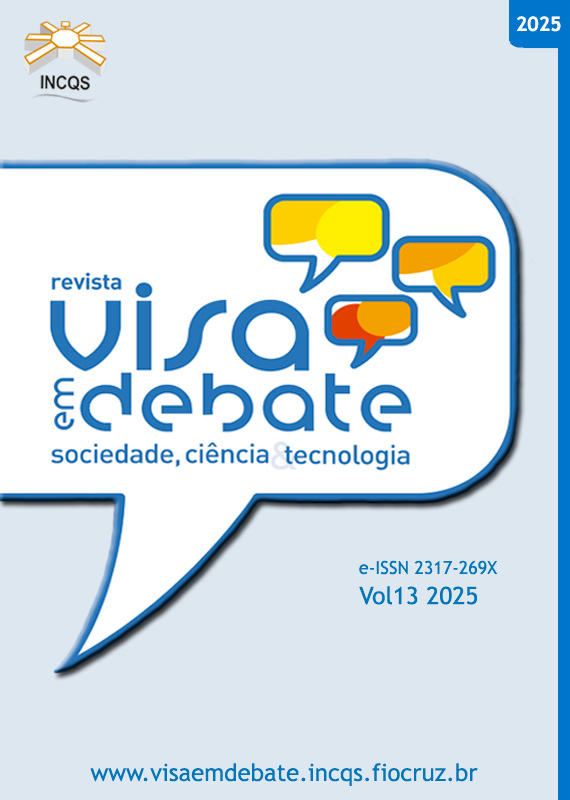Management of antibiotic use in large hospitals in Salvador, BA
Vigil Sanit Debate, Rio de Janeiro, 2025, v.13: e02413 | Published on: 29/09/2025
DOI:
https://doi.org/10.22239/2317-269X.02413Keywords:
Antimicrobial Stewardship, Drug Resistance, Patient SafetyAbstract
Introduction: The management of antimicrobial use is central to the prevention of antimicrobial resistance. Objective: To analyze antimicrobial use management practices in large hospitals in Salvador-BA. Method: A quantitative and descriptive field study was carried out in large hospitals in Salvador, BA. Categories of analysis: institutional structure; existence of antimicrobial use control protocols; education of health professionals; monitoring and evaluation of antimicrobial use. Data were collected online by sending a Google Forms® form to the email address of the Hospital Infection Control Committee, which was answered by the professionals in this service. The hospitals studied were classified according to their antimicrobial use management practices. Results: Of the 23 large hospitals in Salvador and the metropolitan region, this study examined seven
(30.4%) of these units. All of them have policies for the use of antimicrobials, 28.5% without a microbiology laboratory or human and technological resources for managing these drugs. Nurses and microbiologists were not part of the antimicrobial management team at any of the hospitals studied. Clinical protocols in 71.4%, sensitivity profiles in 57.1% and education programs in 42.8%. Conclusions: Antimicrobial stewardship needs to be adapted in most of the hospitals studied, pointing to a problem with the quality and safety of antibiotic use in these institutions. Despite having a formal policy for the use of antibiotics, weaknesses were identified that compromise the management of these drugs and the adoption of intervention measures to contribute to the prevention of antimicrobial resistance.
Downloads
References
1. Corrêa JS, Zago LF, Silva-Brandão RR, Oliveira SM, Fracolli LA, Padoveze MC. et al. Antimicrobial resistance in Brazil: an integrated research agenda. Rev Esc Enferm USP. 2022;56:1-3. https://doi.org/10.1590/1980-220X-REEUSP-2021-0589
2. Felix AMS, Toffolo SR. O enfermeiro nos programas de gerenciamento do uso de antimicrobianos: revisão integrativa. Cogitare Enferm. 2019;24:1-12. https://doi.org/10.5380/ce.v24i0.59324
3. Agência Nacional de Vigilância Sanitária – Anvisa. Diretriz nacional para elaboração de programa de gerenciamento do uso de antimicrobianos em serviços de saúde. Brasília: Agência Nacional de Vigilância Sanitária; 2017.
4. Agência Nacional de Vigilância Sanitária – Anvisa. Nota técnica GVIMS/GGTES/ANVISA Nº 06/2021. Implementação do programa de gerenciamento do uso de antimicrobianos em hospitais. Brasília: Agência Nacional de Vigilância Sanitária; 2021.
5. Tompson AC, Ahandler CIR. Addressing antibiotic use: insights from social science around the world. London: London School of Hygiene and Tropicaol Medicine; 2021.
6. World Health Organization – WHO. Global antimicrobial resistance and use surveillance system (glass) report: early implementatio. Geneva: World Health Organization; 2020.
7. Krockow EM, Colman AM, Chattoe-Brown E, Jenkins DR, Perera N, Mehtar S et al. Balancing the risks to individual and society: a systematic review and synthesis of qualitative research on antibiotic prescribing behaviour in hospitals. J Hosp Inf. 2019;101(4):428-39. https://doi.org/10.1016/j.jhin.2018.08.007
8. Tamma PD, Aitken SL, Bonomo RA, Mathers AJ, Duin V, Clancy CJ. Infectious Diseases Society of America 2022 guidance on the treatment of extended-spectrum β-lactamase producing enterobacterales (ESBL-E), carbapenem-resistant enterobacterales (CRE), and Pseudomonas aeruginosa with difficult-to-treat resistance (DTR-P. aeruginosa). Arlington: Infectious Diseases Society of America; 2022[acesso 4 jul 2022]. Disponível em: https://www.idsociety.org/practice-guideline/amr-guidance
9. Gotterson F, Buising K, Manias E. Nurse role and contribution to antimicrobial stewardship: an integrative review. Int J Nursing Stud. 2021;117. https://doi.org/10.1016/j.ijnurstu.2020.103787
10. World Health Organization – WHO. WHO policy guidance on integrated antimicrobial stewardship activities. Geneva: World Health Organization; 2021.
11. MacDougall C, Polk RE. Antimicrobial stewardship programs in health care systems. Clin Micr Rev. 2005;18(4):638-56. https://doi.org/10.1128/CMR.18.4.638–656.2005
12. Villegas M V, Esparza G, Zurita J. Guía para la implementación de as programa de optimización de antimicrobianos (PROA) a nivel hospitalario. Santo Domingo: Asociación Panamericana de Infectología; 2016.
13. Edwards R, Drumright LN, Kiernan M, Holmes A. Covering more territory to fight resistance: considering nurses’ role in antimicrobial stewardship. J Infect Prev. 2011;12(1):6-10. https://doi.org/10.1177/1757177410389627
14. US Centers for Disease Control and Prevention – CDC. Core elements of hospital antibiotic stewardship programs. Atlanta: US Centers for Disease Control and Prevention; 2019[acesso 17 jul 2022]. Disponível em: <https://www.cdc.gov/getsmart/healthcare/implementation/coreelements.html>
15. Infectious Diseases Society of America – IDSA. Data supplement for “Implementing an antibiotic stewardship program: guidelines by the Infectious Diseases Society of America and the Society for Healthcare Epidemiology of America”. Arlington: Infectious Diseases Society of America; 2016[acesso 4 jul. 2022]. Disponível em: http://www.idsociety.org/Antimicrobial_Agents/#ImplementinganAntibioticSteadshipProgram
16. Olans RN, Olans RD, Alfred M. The critical role of the staff nurse in antimicrobial stewardship: unrecognized, but already there. Clin Infect Dis. 2016;62(1):84-9. https://doi.org/10.1093/cid/civ697
17. Santos RC, Pessalacia JDR, Mata LRF. Risk factors in the management of antimicrobial agents in nursing. Acta Scient. Health Sci. 2016;38(1):49-55. https://doi.org/10.4025/actascihealthsci.v38i1.28505
18. Pereira FGF, Aquino GA, Melo GAA, Praxedes CO, Caetano JA. Conformidades e não conformidades no preparo e administração de antibacterianos. Cogitare Enferm. 2016;21(spe):1-9.
19. American Nurses Association – ANA. Redefining the antibiotic stewardship team: recommendations from the American Nurses Association/Centers for Disease Control and Prevention. Silver Spring: American Nurses Association; 2017[acesso 4 mar 2022]. Disponível em: https://www.cdc.gov/antibiotic-use/healthcare/pdfs/ANA-CDC-whitepaper.pdf
20. Ministério da Saúde (BR). Plano de ação nacional de prevenção e controle da resistência aos antimicrobianos no âmbito da saúde única: 2018-2022 (PAN-BR). Brasília: Ministério da Saúde; 2019.
21. Ministério da Saúde. Portaria Nº 2.616, de 12 de maio de 1998. Expede as diretrizes e normas para a prevenção e o controle de infecção hospitalar. Diário Oficial União, 13 maio 1998.
22. Soon HC, Geppetti P, Lupi C, Kho BP. Medication safety. In: Donaldson L, Ricciardi W, Sheridan S, Tartaglia R, organizadores. Textbook of patient safety and clinical risk management. Berlin: Springer; 2021. https://doi.org/10.1007/978-3-030-59403-9
23. Camerini FG, Cunha TL, Fassarella CS, Henrique DM, Fortunato JGS. Nursing strategies in antimicrobial stewardship in the hospital environment: qualitative systematic review. BMC Nurs. 2024;23:1-11. https://doi.org/10.1186/s12912-024-01753-y
Downloads
Published
Data Availability Statement
Todos os dados estão disponibilizados no artigo.
Issue
Section
License
Copyright (c) 2025 Health Surveillance under Debate: Society, Science & Technology

This work is licensed under a Creative Commons Attribution 4.0 International License.
COPYRIGHT ALLOWANCE The author (s) hereinafter designated as the ASSIGNOR hereby assign and transfer, free of charge, the ownership of the copyrights related to this ARTICLE to the Vigilância Sanitária em Debate: Sociedade, Ciência & Tecnologia (Health Surveillance under Debate: Society, Science & Technology) – Visa em Debate, represented by FUNDAÇÃO OSWALDO CRUZ, established at Av. Brasil, nº 4365, Manguinhos, Rio de Janeiro, RJ, Brazil, CEP 21045-900, under the conditions set out below: (a) The terms and conditions set forth in this Agreement shall apply to the following: 1. The ASSIGNOR declares that they s(he) is (are) the author (s) and owner (s) of the copyrighted property of the ARTICLE submitted. 2. The ASSIGNOR declares that the ARTICLE does not infringe the copyrights and / or other property rights of third parties, that the disclosure of images (if any) has been authorized and that they s(he) assume(s) full moral and / or property liability for its content, before third parties. 3. THE ASSIGNOR assigns and transfers all copyrights relating to the ARTICLE to the ASSIGNEE, especially the rights of editing, publication, translation into another language and reproduction by any process or technique. The ASSIGNEE becomes the exclusive owner of the rights related to the ARTICLE, and any reproduction, totally or partially, is prohibited in any other means of publicity, printed or electronic, without prior written authorization from the ASSIGNEE. 4. The assignment is free and, therefore, there will be no remuneration for the use of the ARTICLE by the ASSIGNEE.







